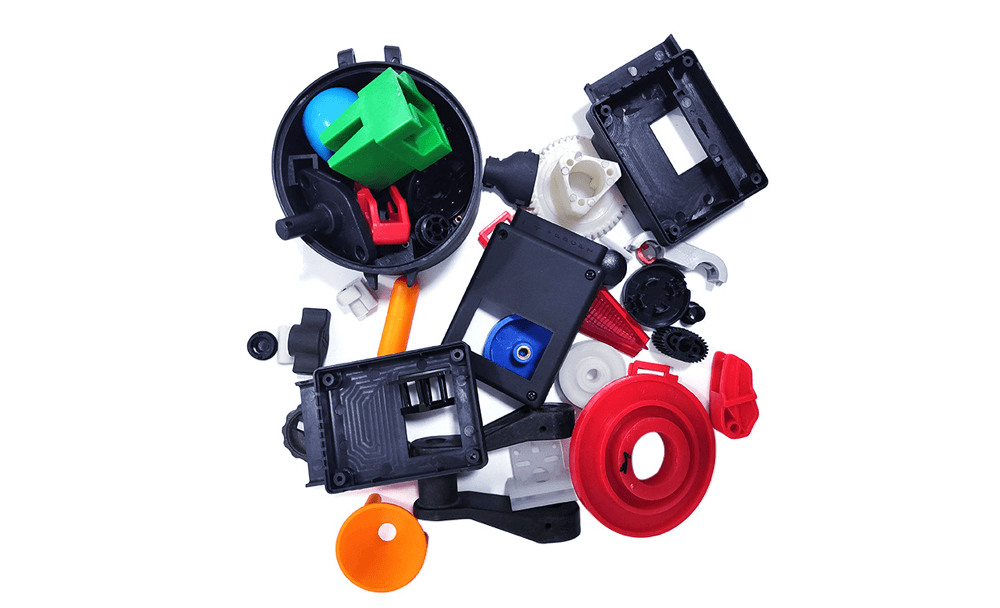What is ABS Plastic and ABS Injection Molding Guide?
Home > Blog >
What is ABS Plastic and ABS Injection Molding Guide?
ABS is an engineering grade thermoplastic with a relatively low melting point. This opaque polymer supports the use of colorants and offers different textures and finishes. ABS is known for its strength and impact resistance.
Due to its outstanding performance and ease of processing, ABS has found extensive applications across various fields.
What is ABS Plastic?

ABS, short for Acrylonitrile Butadiene Styrene, is a terpolymer composed of acrylonitrile, butadiene, and styrene. The varied proportions of these components result in different properties of ABS.
Additionally, the incorporation of diverse additives leads to numerous ABS varieties and grades, each exhibiting distinct performance characteristics.
Types of ABS Plastics

ABS resin offers a range of types such as universal, extrusion, high flow, heat-resistant, cold-resistant, flame retardant, and electroplating. With diverse grades of impact strength and properties, it caters to various purposes.
Universal ABS Plastic:
Universal ABS lacks special additives, ensuring high output and excellent fluidity (typically with a melt flow rate of 1.5~10g/10min).
Universal ABS resin is available in various varieties and brands, categorized by impact resistance into medium (rubber content 8%~14%), high (rubber content 14%~18%), and ultra-high impact resistance types (rubber content exceeding 18%).
Widely applicable, it can be used for injection molding in casings, automotive parts, electrical components, mechanical parts, refrigerator linings, lamps, furniture, safety hats, and miscellaneous products.
Extrusion ABS Plastic
Extrusion ABS plastic is specifically designed for extrusion processes. It is formulated to exhibit favorable characteristics during extrusion manufacturing methods. The details of its composition and properties may vary based on the specific requirements of extrusion applications.
High Flow ABS Plastic
High flow ABS plastic is engineered to have excellent fluidity during the injection molding process. This type of ABS is characterized by a high melt flow rate, typically exceeding the rates of standard ABS grades.
The enhanced flow properties make it well-suited for applications where intricate or complex molds need to be filled with ease and efficiency. High flow ABS is often chosen for manufacturing processes that benefit from improved moldability and faster production cycles.
Heat-Resistant ABS Plastics
Heat-resistant ABS typically has a heat deformation temperature of 80 to 100 °C, dependent on formulation and processing conditions.
This range signifies ABS’s ability to maintain shape and structural integrity in moderate thermal environments, surpassing some polymers like polypropylene (PP), polyethylene (PE), and nylon 6 (PA6), but falling short of heat-resistant polymers such as acetal (POM) and polycarbonate (PC).
Cold-Resistant ABS Plastic
Cold-resistant ABS surpasses general ABS in low-temperature resistance, withstanding temperatures as low as -60 °C. Exhibiting high impact strength, it is suitable for environments below 0 °C, making it ideal for injection parts requiring superior cold resistance.
Flame Retardant ABS Plastic
Flame-retardant ABS is produced through two primary methods. One involves adding flame retardants, like bromide, but this can reduce ABS toughness.
The second method involves blending with refractory resin, providing effective flame retardancy without compromising ABS toughness.
This blend is suitable for injection molding various flame-retardant parts, including those used in computers, telecommunications equipment, and other applications.
Electroplating ABS Plastic
Electroplated ABS exhibits stronger adhesion to metal coatings than universal ABS, making it easily electroplatable. This plastic variety enhances product aesthetics, reduces linear expansion, and improves surface thermal and electrical conductivity after electroplating.
ABS electroplated parts can substitute certain metals in the injection molding of various automotive, electrical, decorative, and furniture components.
Performance of ABS
Given the intricate nature of ABS components, there is significant performance variation among its different constituents. However, general-purpose ABS typically exhibits the following performance characteristics.
Physical property
ABS possesses excellent mechanical properties, including hardness, rigidity, and toughness, making it widely utilized in general engineering plastics.
Pure ABS resin is light ivory, opaque, non-toxic, with a relative density of about 1.05 and a melt flow rate of 0.2% to 0.7%. When burned, ABS has slow combustion, a yellow flame with black smoke, and softens and chars, emitting a burning rubber odor without melting or dripping.
wever, general-purpose ABS typically exhibits the following performance characteristics.
Heat resistance
ABS offers moderate heat resistance, with a thermal deformation temperature of around 85°C under 1.86MPa pressure. Heat treatment can elevate this temperature by 10°C.
ABS operates within a temperature range of -40°C to 85°C, generally not surpassing 100°C.
It demonstrates a thermal conductivity of 0.16-0.29W/(m·K) and a coefficient of linear expansion between (6.2-9.5)*10^-5K^-1, making it one of the thermoplastics with a relatively small expansion coefficient and facilitating the production of highly accurate dimensional products.
Heat resistance
ABS offers moderate heat resistance, with a thermal deformation temperature of around 85°C under 1.86MPa pressure. Heat treatment can elevate this temperature by 10°C.
ABS operates within a temperature range of -40°C to 85°C, generally not surpassing 100°C.
It demonstrates a thermal conductivity of 0.16-0.29W/(m·K) and a coefficient of linear expansion between (6.2-9.5)*10^-5K^-1, making it one of the thermoplastics with a relatively small expansion coefficient and facilitating the production of highly accurate dimensional products.
Mechanical property
ABS is a robust thermoplastic with effective impact resistance. The rubber component absorbs external impact energy, preventing silver line formation. Even at -40°C, ABS maintains considerable impact strength and excellent low-temperature toughness.
Moreover, ABS shows impressive creep resistance; under a 7.2MPa load, pipes remain unchanged in size for up to two years.
Chemical Resistance
ABS withstands water, inorganic salts, alkali, and dilute acids but is vulnerable to oxidizing acids like agricultural sulfuric acid and agricultural nitric acid.
Prolonged exposure to hydrocarbons, alcohols, mineral oils, and vegetable oils may cause stress cracking in ABS, with minimal impact on non-stress products. Ketones, aldehydes, esters, and chlorinated hydrocarbons can dissolve ABS or form emulsions.
Weather Resistance
ABS resin’s poor weather resistance, due to double bonds, leads to vulnerability to UV light, heat, and oxygen, causing oxidation and degradation.
After six months outdoors, ABS products experience a 45% impact strength reduction, exhibiting aging through hardening and brittleness under UV light, heat, and oxygen.
To enhance weather resistance, carbon ink and phenolic antioxidants, particularly cost-effective and stable carbon black, are commonly added as stabilizers and colorants for ABS.
ABS Injection Molding Guide

Injection temperature
The processing temperature shall not exceed 250℃. Generally speaking, the material tube temperature of the plunger injection machine is 180~230 °C, the material tube temperature of the screw injection machine is 160~220 °C, and the nozzle temperature is about 200 °C.
Among them, the processing temperature of heat-resistant grade, electroplating grade and other grades of resin can be slightly higher, and the processing temperature of flame retardant grade, general grade, impact resistance, etc., should be lower.
ABS Injection Mold Temperature
Increasing the mold temperature is beneficial to melt filling, improve the surface finish of the parts, reduce the internal stress, and improve the electroplating property, but the shrinkage rate of the parts increases and the molding cycle is prolonged.
Therefore. For parts with high surface quality and performance requirements and complex shapes, the method of heating the mold can be used to control the mold temperature at 60~70 °C.
ABS Injection Molding Pressure
Injection pressure selection depends on part wall thickness, equipment type, and resin grade. For thin-wall, long process, small gate, heat-resistant, or flame retardant resin products, opt for higher pressure.
While higher injection pressure aids mold filling, excessive pressure can lead to release difficulty or damage. Similarly, to minimize internal stress, keep pressure holding pressure controlled at 60~70MPa.
ABS Injection Molding Speed
Injection velocity impacts ABS melt fluidity. Slow speed results in part surface defects like corrugation and poor welding.
Fast speed leads to inadequate exhaust, low surface finish, and ABS decomposition due to increased friction heat, reducing mechanical properties. Opt for medium to low speed in normal production, reserving high speed for challenging mold filling situations.
ABS Plastic Molding Post Processing
ABS parts typically have internal stresses, but stress cracking is uncommon. For low-usage parts, heat treatment is unnecessary.
For high-performance requirements, heat the part in hot air at 70-80°C for 24h, then gradually cool to room temperature.
To test stress in ABS parts, immerse them in glacial acetic acid. Cracks within 5~15s indicate high internal stress, while no cracks after 2min suggest low internal stress.
What problems should be paid attention to during ABS plastic injection molding process?

ABS has excellent mechanical properties, chemical resistance and is easy to process. It exhibits smooth melt flow, high dimensional stability and a smooth surface during molding.
As a widely used injection molding material, It needs to pay attention to some problems in the injection molding process.
#1. ABS resin is easy to absorb moisture, the water absorption rate is about 0.3%, and sometimes the surface water absorption rate can reach 0.8%, so it is often necessary to dry before forming, so that the water absorption is reduced by less than 0.2%.
The feeding device with drying system is used in the production, and the circulating air drying oven can also be used, the drying temperature is 70~90℃, and the time is about 6h. Parts with a highly polished surface can be obtained using the dried resin.
ABS has good dyeing property, and can be colored by float dyeing or master dye method according to needs.
#2. ABS, being an amorphous polymer, lacks a distinct melting point but has a viscous flow temperature of around 160°C and a decomposition temperature exceeding 250°C. This makes it highly moldable.
Tailor molding process parameters based on the specific material conditions in injection molding, considering brand and type.
#3. The melt viscosity of ABS is moderate, and the melt viscosity is sensitive to molding temperature and injection pressure.
With the increase of tube temperature and injection pressure, melt viscosity decreases and fluidity increases, which is conducive to mold filling.
#4. ABS has a low shrinkage rate, generally 0.4% to 0.8%, which can produce products with high dimensional accuracy.
In addition, if the mold is polished or polished, the part has a high gloss and rich color.
#5. The parts after forming can usually not be heat treated, if the parts need surface plating, spraying and other decoration, can be heat treated at 75~90℃ for an appropriate time to eliminate internal stress and obtain decorative products with good appearance.
#6. Avoid gaps and sharp corners to prevent stress concentration. Design a mold with a release Angle of about 1.0 °. Ensure that the gate thickness exceeds 1/3 of the product wall thickness and avoid placing the gate on the plating surface.
Author

Gavin Leo is a technical writer at Aria with 8 years of experience in Engineering, He proficient in machining characteristics and surface finish process of various materials. and participated in the development of more than 100complex injection molding and CNC machining projects. He is passionate about sharing his knowledge and experience.
